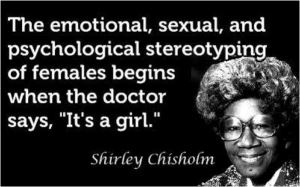Have you ever stopped to consider how much information is embodied and compacted into the words “Women” and “Men” and their synonyms? Not just information per se but powerful stereotypes and assumptions that embody a whole dictionary of meaning, even though it is probably inaccurate to a large degree. Upon hearing “male” or “female or upon seeing someone who is a “Man” or a “Women” or coming across a name that is “masculine” or “feminine,” the brain–largely unconsciously–jumps for joy at all that has suddenly been conveyed, all of the mystery that has been silenced.
If this were an activity in one of my classes, I would ask, “What assumptions do people make upon these categories or what have they made historically speaking?” We would make various lists on the board and talk about them. Students always do really well with this kind of discussion-based, interactive lesson technique.
This activity would also be used to reinforce, for example, that not everyone is able-bodied, heterosexual or not even sexual (asexual people do exist!)–homogenous assumptions hurt people.
If we think critically and deeply, we can use a not-so-typical set of assumptions in positive ways, ways to better understand all people and make even more positive differences. For example, a still safe assumption per se, as bell hooks would say, is that Men–as an institutionalized group–are raised to think they are superior and their display of emotions, especially sadness, are signs of weakness and thus inappropriate. On another more troubling point, between 1 in 4 and 5 Women are raped at some point. If we can fully embody and understand these realities, we might have hope of making change. Give the high percentage of Women raped, it is an everyday fear and reality for all Women and all Men.
Part II will look at the countless limitations and problems, from a biological, cultural, psychological, and sociological perspective, on even having the labels “male” and “female” and their word-brothers. Part II can be found here: “The Good Men Project” and Calls for Full Inclusion (Or, “Women” and “Men,” Part II) – Website Review Series #3
